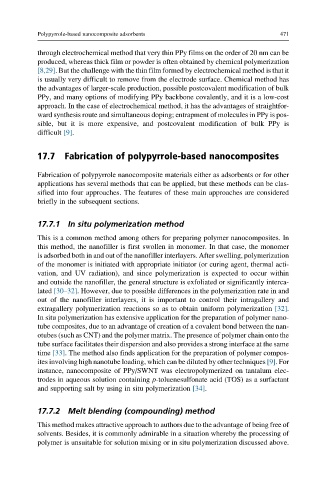Page 518 - Polymer-based Nanocomposites for Energy and Environmental Applications
P. 518
Polypyrrole-based nanocomposite adsorbents 471
through electrochemical method that very thin PPy films on the order of 20 nm can be
produced, whereas thick film or powder is often obtained by chemical polymerization
[8,29]. But the challenge with the thin film formed by electrochemical method is that it
is usually very difficult to remove from the electrode surface. Chemical method has
the advantages of larger-scale production, possible postcovalent modification of bulk
PPy, and many options of modifying PPy backbone covalently, and it is a low-cost
approach. In the case of electrochemical method, it has the advantages of straightfor-
ward synthesis route and simultaneous doping; entrapment of molecules in PPy is pos-
sible, but it is more expensive, and postcovalent modification of bulk PPy is
difficult [9].
17.7 Fabrication of polypyrrole-based nanocomposites
Fabrication of polypyrrole nanocomposite materials either as adsorbents or for other
applications has several methods that can be applied, but these methods can be clas-
sified into four approaches. The features of these main approaches are considered
briefly in the subsequent sections.
17.7.1 In situ polymerization method
This is a common method among others for preparing polymer nanocomposites. In
this method, the nanofiller is first swollen in monomer. In that case, the monomer
is adsorbed both in and out of the nanofiller interlayers. After swelling, polymerization
of the monomer is initiated with appropriate initiator (or curing agent, thermal acti-
vation, and UV radiation), and since polymerization is expected to occur within
and outside the nanofiller, the general structure is exfoliated or significantly interca-
lated [30–32]. However, due to possible differences in the polymerization rate in and
out of the nanofiller interlayers, it is important to control their intragallery and
extragallery polymerization reactions so as to obtain uniform polymerization [32].
In situ polymerization has extensive application for the preparation of polymer nano-
tube composites, due to an advantage of creation of a covalent bond between the nan-
otubes (such as CNT) and the polymer matrix. The presence of polymer chain onto the
tube surface facilitates their dispersion and also provides a strong interface at the same
time [33]. The method also finds application for the preparation of polymer compos-
ites involving high nanotube loading, which can be diluted by other techniques [9]. For
instance, nanocomposite of PPy/SWNT was electropolymerized on tantalum elec-
trodes in aqueous solution containing p-toluenesulfonate acid (TOS) as a surfactant
and supporting salt by using in situ polymerization [34].
17.7.2 Melt blending (compounding) method
This method makes attractive approach to authors due to the advantage of being free of
solvents. Besides, it is commonly admirable in a situation whereby the processing of
polymer is unsuitable for solution mixing or in situ polymerization discussed above.

